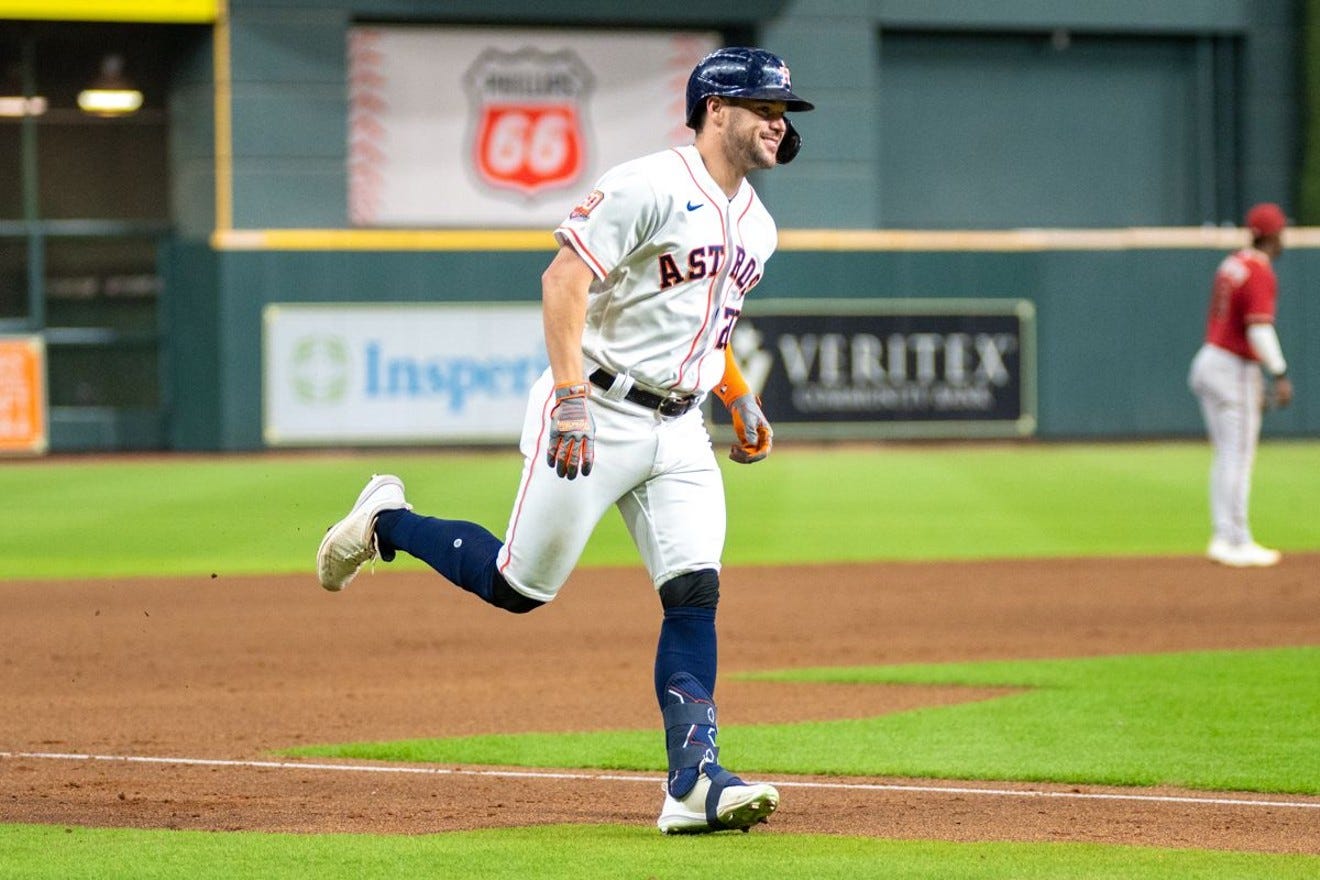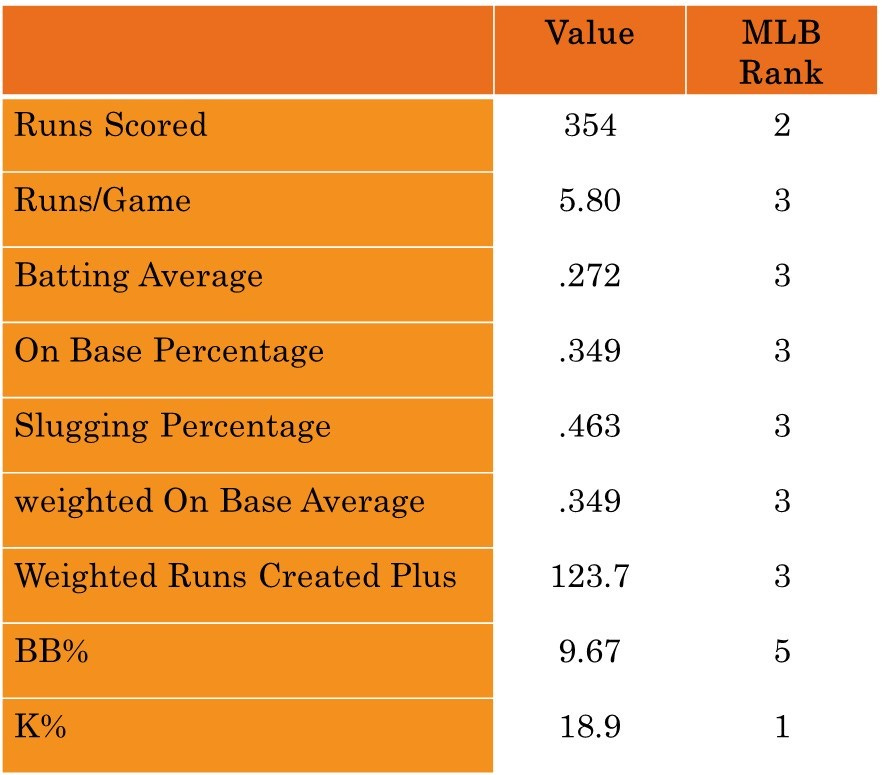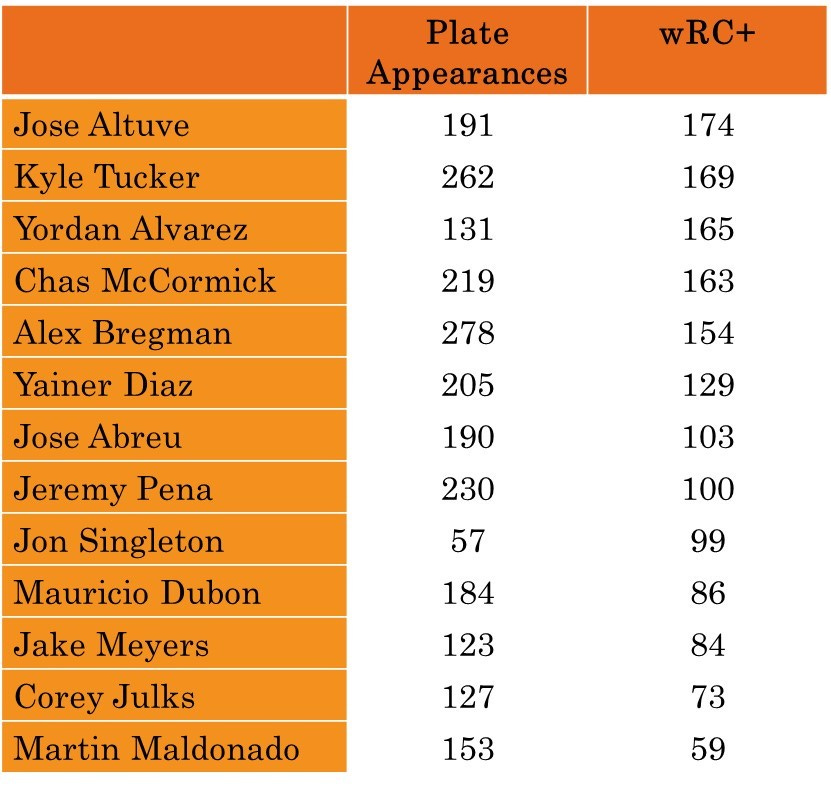An Offense-First Team
The Astros offense has made a huge turnaround from a mid-tier offense to one of the best in the majors. And just in time to make up for a pitching staff that has made the opposite turnaround.
On June 19, the Astros lost 11-1 to the Mets. It was their 5th straight loss and their 10th loss in their last 13 games. It moved their record to 39-34, an 87 win pace, and dropped the team to 6 1/2 games behind the Rangers in the AL West.
And then the season turned around.
Since then, the Astros have gone 38-24, a 99 win pace. They have moved ahead of the Rangers in the AL West and are in a virtual tie with the Mariners for the division lead.
And how did the Astros manage to do this? Their offense carried them.
Since June 20, when the Astros began a two game win streak and a stretch of 10 wins in 14 games, the Astros have been one of the best offensive teams in the majors.
The chart below shows the Astros offensive production since June 20 and the team’s rank among all major league teams. They have scored the second most runs of any team in baseball and are third in runs per game, batting average, on base percentage, wOBA, and wRC+.
You can also see from the BB% and K% numbers that this offense looks a lot like the offenses we got used to seeing from 2017 through 2021. The Astros are good but not great at drawing walks (5th in the majors), but are the best team in baseball at avoiding strikeouts and putting balls in play.
Part of what is notable about the team’s offensive output from June 20 to today is how different it is from what we saw in the first 73 games of the season. Through June 19, the Astros collectively slashed .244/.313/.398 for a wOBA of .309 and a wRC+ of 96.1 They were 17th in the majors in runs scored. In short, they were—at best—an average offense, scuffling to put runs on the board and to support the effective pitching staff.
As you can see, the team has increased its offensive production significantly since then, turning into one of the best offenses in baseball.
Broad Offensive Contributions
Which players are responsible for the team’s offensive surge since June 20? The answer is a lot of them. The Astros never have the biggest star in baseball or in the AL West, but they have the broadest collection of really good players.
Jose Altuve leads the team with a 174 wRC+ since June 20, which is good for 8th best in the majors (and 3rd best in the division). But the Astros have five players among the top 25 in wRC+ since June 20. One-fifth of the top 25 all come from one team—ours.
The top of that list helps show why the team’s offense has improved so much. For one, it’s gotten more plate appearances from Jose Altuve, who returned from the broken thumb he suffered that cost him the first two months of the season. It features a much improved Alex Bregman, who, as always, got off to a slow start in 2023. He has returned to All-Star form.
It also features Chas McCormick, who has turned into the surprise story of the 2023 season. Well, really, McCormick is the surprise player of the Astros last three seasons, and shows how the Astros player development abilities have allowed the team to remain at the top of the division over the last several years. McCormick was drafted in the 21st round—that round of the draft does not exist anymore—and has been developed not only into a useful major leaguer, but a high quality starting player.
Yainer Diaz is not as strong a hitter as the top five—his lack of walks will always hold down his value some. But he hits the ball often and real hard. His increased playing time is another important reason that the offense has improved over the last two plus months.
The table also shows you another reason why offenses are good—a high floor. Jeremy Pena is one of the less impressive hitters in the everyday lineup. But he is exactly league average—at 100. If one of your worst hitters is league average, well, then your average is above the league average.
The part time players are, of course, worse at hitting than the every day players. Dubon and Meyers are players whose offense is acceptable because of their excellent gloves. Corey Julks has slumped terribly over this time period. The Astros value Martin Maldonado for his intangible qualities.

Making Up for a Rotation Turnaround
The offensive turnaround has been vital for the Astros for the obvious reason that it is good to score more runs. It leads to more wins.
But the turnaround has been more important because it has come at a time when the Astros pitching has declined. On Memorial Day, I wrote that the Astros “pitching has carried them to a winning record so are this season and the team will need their arms to carry the load throughout the rest of the season.”
Three months later, all I can say to that is “welp.”
Since June 20, the Astros collectively have a 4.77 runs per game. Their 4.46 ERA is good for 17th best in the majors in that period. This is also a turnaround. In that Memorial Day article, I noted that the Astros had given up 3.48 runs per game, the best in the American League.
Most of that damage has come from the starting rotation. In the 62 starts since June 20, Astros starters have given up 180 earned runs in 337 innings. That’s good for a 4.81 ERA, which is 25th best in the majors over that time period.
Yikes.
Obviously, the best hope for the Astros over the final month of the season is that we get the offense of the last two and a half months matched with the pitching of the first two and a half months. Of course, there are only a handful of teams in MLB history who have combined that level of play at the plate and on the mound.
We can’t know what is coming in the future. What we do know is that the offense has made a huge turnaround since mid-June. And thank goodness. The Astros have really needed it.
wRC+ stands for weighted Runs Created Plus. It uses a statistical formula to measure how many runs a player creates at the plate. The plus tells you that it is scaled so that 100 is league average. Every 1 unit above 100 is the percentage better than league average a player’s offensive contributions are. So that Chas McCormick has a wRC+ of 163 for this time period means he has been hitting 63% better than a league average hitter.
Behind Shohei Ohtani and Corey Seager.





